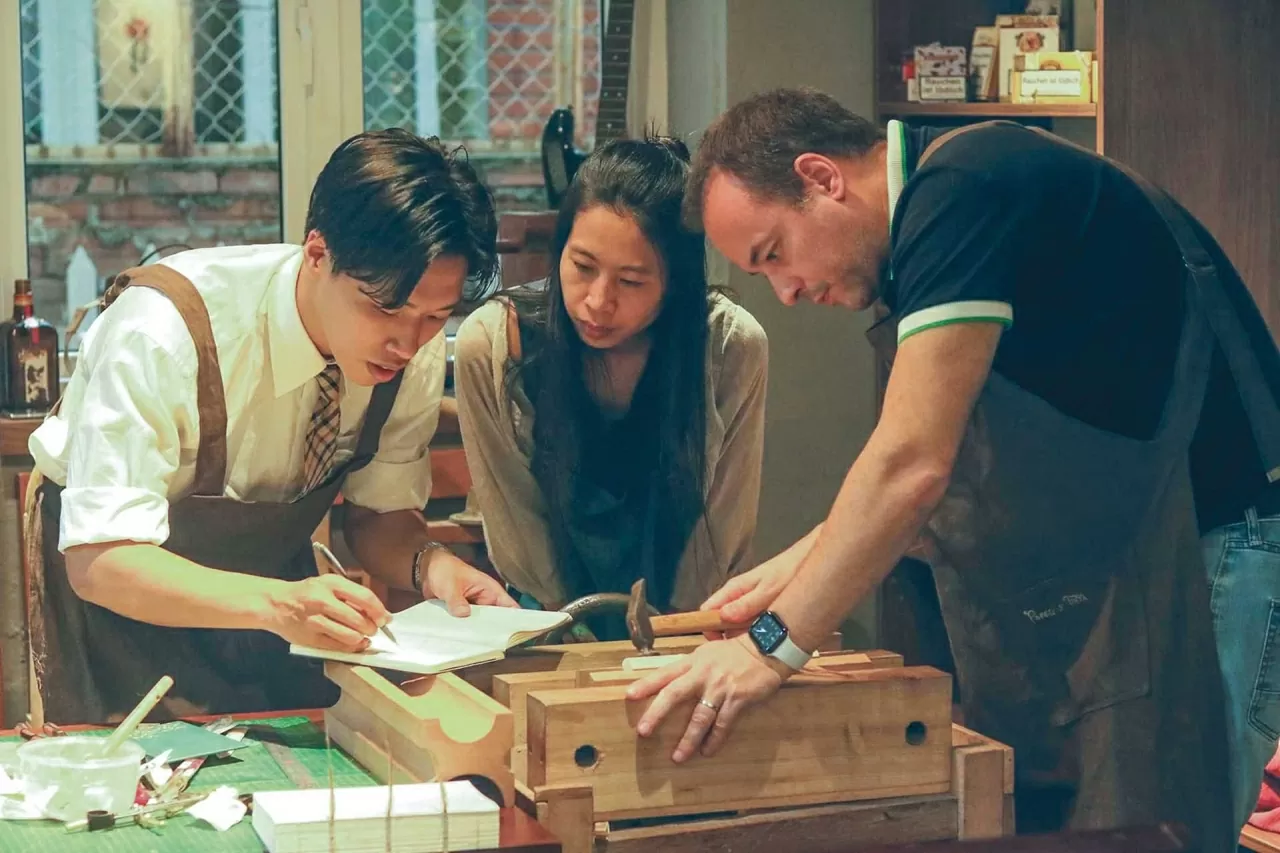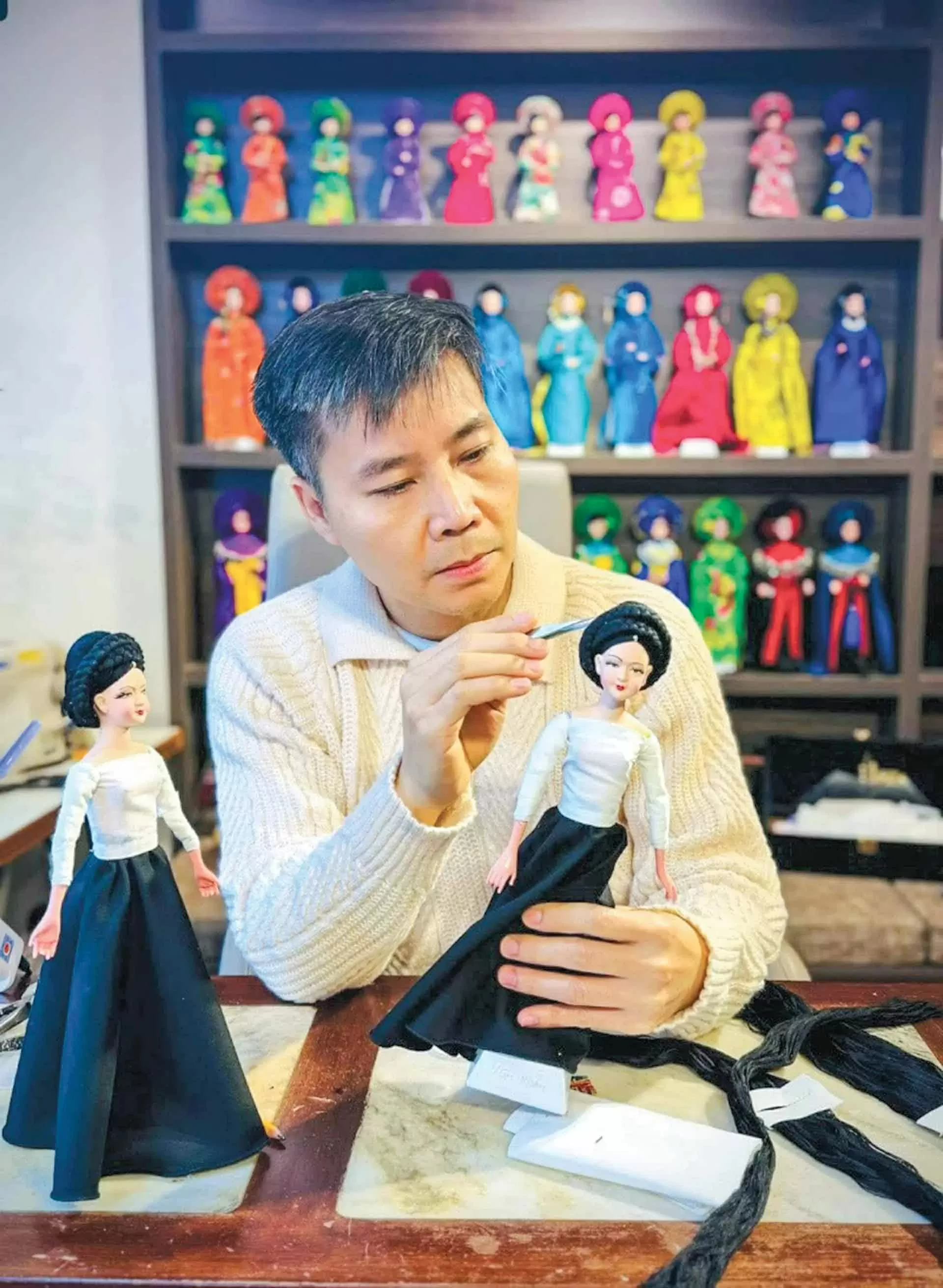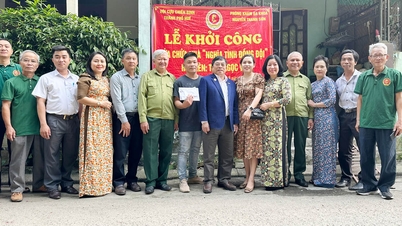Dialogue between two generations
In the summer of 2023, at the Temple of Literature - Quoc Tu Giam space, the exhibition "Dialogue with Hang Trong folk paintings" attracted a large number of art lovers in the capital.
 |
| Exhibition "Dialogue with Hang Trong folk paintings" at the Temple of Literature - Quoc Tu Giam. (Photo: Trang Nhung) |
In the ancient campus, 22 young artists brought 38 works inspired by Hang Trong folk paintings, placed next to 29 original paintings by artisan Le Dinh Nghien - the last person to fully understand the process of making Hang Trong paintings.
Familiar images such as "Five Tigers", "Four Palaces", "Carp Watching the Moon"... are recreated using lacquer, silk, do paper, and contemporary media. Some works retain the original spirit, while others break the traditional layout to convey the perspective of today's generation.
Over the past decade, Hang Trong folk paintings have become a lasting source of inspiration for many generations of students at the Vietnam University of Fine Arts.
Under the guidance of artist Nguyen The Son – the exhibition curator and also the "companion teacher" in the project "From Tradition to Tradition" – the young artists have persistently explored the visual and spiritual values of the heritage.
During the three years of implementation, the project not only aroused the love for folk art, but also opened up a space for dialogue between the past and the present. Young artists learned how to perceive, approach and recreate Hang Trong with their own creative language – both inherited and innovated.
In particular, the lessons with artist Le Dinh Nghien, who has spent more than 60 years preserving and conserving the Hang Trong folk paintings, have become a journey back to the roots. From wood carving techniques, color mixing to stories about the profession, students are touched by the spirit of genuine and profound artistic labor.
From there, they bring that folk breath into new materials: silk, dó paper, lacquer, oil painting, even digital graphics, contemporary design and installation, making the heritage no longer a distant memory, but alive in today's creative life.
When heritage is no longer the past
Undeniably, Hanoi is a special land for experiments in finding traditional values. Here, every street corner, temple, or old house carries a layer of cultural memory, touching the emotions of young artists.
Typically, 25-year-old Tran Trung Hieu in Hanoi has chosen a very unique path for himself: pursuing the craft of manual bookbinding, which has a history of thousands of years but is gradually fading away in Vietnam.
Having graduated from interior design, Hieu came to the profession of manual bookbinding through YouTube tutorials , and then became so passionate that he taught himself and made his own tools. Without any teacher to guide him, he read foreign documents, patiently learning each technique: from sewing, gluing, embossing to decorating the cover.
 |
| Young man Tran Trung Hieu at a class on manual bookbinding. (Photo: NVCC) |
Hieu founded Sao Bac Bookbinding - where he and his colleagues create high-end handcrafted art publications, bringing the spirit of the ancient craft into modern life.
Works such as Michelangelo: Six masterpieces of life, Almanach – World civilizations... are all hand-bound, sewn with papyrus, covered with goatskin, and gilded with gold, inspired by European books of the 15th-19th centuries. Each book is a unique work, containing both emotions and traces of time.
Not stopping at personal creativity, Hieu also organizes workshops to teach young people how to make books in the traditional French style, contributing to spreading the spirit of craftsmanship in the community.
In 2024, he was one of two main speakers of the bookbinding workshop at the Hanoi Book Fair, and is currently preparing to participate in the international art bookbinding competition in France - hoping to bring the image of Vietnamese craftsmen to the world.
For Hieu, bookbinding is not only a profession but also an art of the hands – where each stitch, each stamp is a way to honor knowledge and time. From the books he makes, people can see not only his ingenuity, but also his deep love for cultural heritage and the spirit of preserving human knowledge.
Creativity from the source
Hanoi, a thousand-year-old city, is not only attractive for its ancient beauty but also for its music – where memories and the present blend together in rhythm. In the midst of modern streets, Hanoi music still resonates with melodies bearing the mark of heritage, from ca tru, hat xam to youthful and vibrant creations.
When talking about Hanoi music, we are talking about Xam singing – a genre that once resounded in market corners and riverside stations. After a period of decline, Xam singing has now revived on the Dong Xuan singing mat, attracting a large number of listeners, from the people of the old town to foreign tourists.
In the small space, the sound of clappers and the voices of female singers resonate, as if reminding us of an ancient, elegant and profound Hanoi. Ca tru artists not only perform, but also quietly teach, keeping this heritage flowing in modern life.
 |
| Singer Ha Myo. (Photo: NVCC) |
From those ancient values, many young artists in Hanoi have found new creative inspiration. A typical example is Ha Myo (Nguyen Thi Ngoc Ha) - the pioneer singer who combined Xam singing with pop and EDM.
Her MV Xam Ha Noi created a big buzz, not only because of its bold experimentation, but also because of its spirit of dialogue with tradition, bringing folk music out of the old framework to reach the younger generation.
Similarly, with a passion for traditional culture, artist Nguyen Hoang Anh (Hoang Mai district, Hanoi) has researched and created unique handmade dolls, wearing traditional costumes of 54 ethnic groups.
Born in the ancient village of Duong Lam, Nguyen Hoang Anh grew up amidst the moss-covered tiled roofs and the quiet pace of life in Hanoi’s Old Quarter. From an early age, he was fascinated by folk cultural values and was always troubled by the fact that traditional souvenirs were gradually being forgotten, especially the dusty dolls on the stalls.
Since then, he has cherished the dream of creating dolls with Vietnamese souls - not only for display but also as a bridge to bring national culture closer to everyone.
Hoang Anh chose to recreate the traditional costumes of 54 Vietnamese ethnic groups on small dolls. He spent a lot of time wandering around highland villages, learning about the lives, customs, patterns and unique clothing materials of each ethnic group.
Each product is a work of art meticulously crafted by him: from the composite blank, face, figure to every small detail of the costume such as scarf, necklace, sandals, basket or gong.
Without any professional training in fashion design, Hoang Anh learned embroidery and color coordination from painting, so that each miniature dress is both authentic and aesthetically harmonious.
For him, doll making is not only a manual labor but also a fusion of art and culture. Each stitch tells a story about the people and land of Vietnam.
 |
| Mr. Nguyen Hoang Anh creates ethnic dolls. (Photo: Kieu Trang) |
Thanks to his creativity and dedication, Hoang Anh's collection of "Dolls of 54 Vietnamese Ethnic Groups" has become a diplomatic gift chosen by the National Assembly, contributing to promoting Vietnamese culture to the world.
These dolls now appear at airports, tourist attractions and Hanoi's Old Quarter, loved by international visitors as a delicate symbol of Vietnam.
Hoang Anh wishes to complete the collection of 54 ethnic groups and create a line of double dolls in ethnic wedding costumes. He believes that each doll will be a "cultural ambassador" carrying the beauty, story and pride of Vietnamese identity on the journey of global integration.
***
Traditional heritage, when touched by young people with the emotions of the times, has a new life. The capital Hanoi today is witnessing a generation of young artists creating a trend of slowing down, looking deeper to find the beauty that never gets old. This affirms that they love this land in their own way, through art, memories and the desire to continue tradition.
Source: https://baoquocte.vn/giu-hon-xua-trong-hinh-hai-moi-cua-nghe-thuat-tre-ha-noi-332050.html




![[Photo] Panorama of the Patriotic Emulation Congress of Nhan Dan Newspaper for the period 2025-2030](https://vphoto.vietnam.vn/thumb/1200x675/vietnam/resource/IMAGE/2025/11/04/1762252775462_ndo_br_dhthiduayeuncbaond-6125-jpg.webp)
![[Photo] The road connecting Dong Nai with Ho Chi Minh City is still unfinished after 5 years of construction.](https://vphoto.vietnam.vn/thumb/1200x675/vietnam/resource/IMAGE/2025/11/04/1762241675985_ndo_br_dji-20251104104418-0635-d-resize-1295-jpg.webp)
![[Photo] Ho Chi Minh City Youth Take Action for a Cleaner Environment](https://vphoto.vietnam.vn/thumb/1200x675/vietnam/resource/IMAGE/2025/11/04/1762233574890_550816358-1108586934787014-6430522970717297480-n-1-jpg.webp)
![[Photo] Ca Mau "struggling" to cope with the highest tide of the year, forecast to exceed alert level 3](https://vphoto.vietnam.vn/thumb/1200x675/vietnam/resource/IMAGE/2025/11/04/1762235371445_ndo_br_trieu-cuong-2-6486-jpg.webp)






































































































Comment (0)